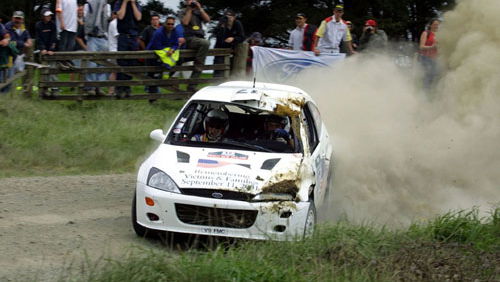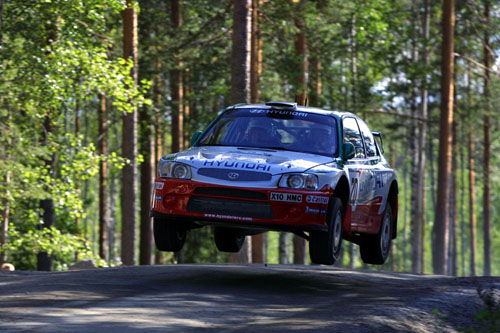Organisers set record straight on Delecour crash.
Telstra Rally Australia organisers have met with Francois Delecour in an attempt to defuse the Frenchman's anger over the circumstances surrounding his event-ending accident.

Telstra Rally Australia organisers have met with Francois Delecour in an attempt to defuse the Frenchman's anger over the circumstances surrounding his event-ending accident.
The incident, on SS13 at Wellington Dam on Saturday, left Delecour's co-driver Daniel Grataloup in hospital with multiple fractures and a collapsed lung after the duo's Ford Focus left the road and hit a tree. In interviews with the media, Delecour made a number of statements about the organisers' response which, according to the evidence from the data log which records all communication in the Telstra Rally Australia Command Centre, were not accurate.
Delecour has now been appraised of the facts of the situation, which are:
* the accident occurred at approximately 11.38am;* the organisers became aware of the accident at 11.41am;* the organisers' first medical helicopter, with its chief medical officer Dr Ben Williams on board, landed at the accident scene just after 11.42am. Kenneth Eriksson, the driver of the third car on the road, has confirmed the helicopter was already there when he arrived at the scene. This helicopter also carried the 'Eye in the Sky' safety monitoring camera and the medical first intervention kit;* at 11.44am, having conducted a primary medical survey of Grataloup's injuries, and found his condition to be "satisfactory" - ie. with no immediate threat to life, airways clear, breathing satisfactory and circulation intact - Dr Williams requested assistance from the second medical intervention helicopter, which was on the ground 400 metres from the accident with its engine running;* the second medical intervention helicopter landed less than three minutes later, at 11.46am, with deputy chief medical officer Dr Rik Hagen - a trauma specialist - and Dr Roger Swift - the senior trauma specialist at Perth's Sir Charles Gairdner Hospital - on board;* Grataloup, who was still in the car experiencing considerable pain in his right chest and shoulder area, was examined by Drs Hagen and Swift with particular attention to his cervical, thoracic and lumbar spine. As he was becoming agitated and was in pain, a clinical decision was made to remove him from the car;* it was decided that it was not necessary to use the cutting equipment, which was in the first intervention vehicle, or to use the KED extraction device. Cutting the car would have achieved nothing except for considerable delay in treatment and the use of the KED was not clinically indicated. At the roadside, Grataloup received initial intravenous therapy, consisting of IV fluids and analgesia;* once Grataloup was stabilised, the doctors requested the large helicopter, which was at Harvey, to evacuate him to a major hospital in Perth. The medical team was concerned that he may have had a pneumothorax, or punctured lung;* at approximately 11.54am, the first intervention vehicle and the ambulance from the SOS point less than 5km away arrived. These vehicles were not dispatched from their SOS point until the organisers were certain that all cars on the course had received the yellow flag and had slowed accordingly. This was able to be established using data from the GPS vehicle tracking system which Telstra Rally Australia monitors in its command centre;* the ambulance was used to accommodate Grataloup to provide shelter from the inclement weather;* standard emergency medical intervention practice - acute trauma life support - is to stabilise the patient and treat them on the spot before moving them;* by 12.48pm, Grataloup was loaded on the helicopter for non-urgent transport to the St John of God Hospital in Murdoch, Perth. It was requested to fly at lowest possible safe altitude in view of the possibility of pneumothorax. He was accompanied by a specialist anaesthetist and senior flight nurse from the Royal Flying Doctor Service;* the helicopter was refuelled at Harvey Oval on the way to Perth to ensure it would have sufficient fuel in the event of having to intervene in another medical emergency;
Chief medical officer Dr Williams and the FIA medical delegate Dr Jean Duby met with Delecour and explained to him the medical intervention process. Dr Hagen has also explained the procedure to Grataloup.
Clerk of the Course, Garry Connelly, has suggested that, despite the fact that all team doctors had been fully briefed on the medical intervention and evacuation protocols, it might be beneficial if all team managers and crews were made aware of these procedures.
Connelly praised the FIA for its initiative in creating the post of FIA medical delegate, whose role this year has been to audit all medical and intervention procedures at events in the FIA World Rally Championship. Connelly said he expects that this will result in consistency and best practice.
Delecour's response to the meeting was not recorded.
